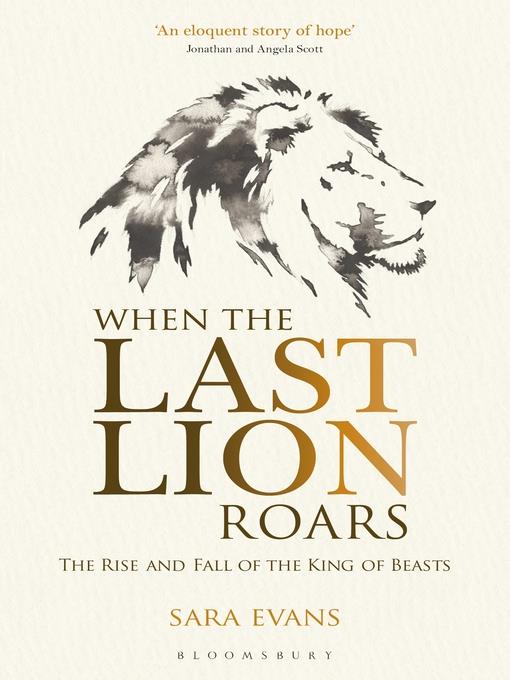
When the Last Lion Roars
The Rise and Fall of the King of the Beasts
کتاب های مرتبط
- اطلاعات
- نقد و بررسی
- دیدگاه کاربران
نقد و بررسی

September 1, 2018
Award-winning writer and photojournalist Evans has performed a work of scholarship documenting the adversities lions face--hunting, disease, loss of habitat, and shallow gene pools, among others. The result is a work of outstanding, exhaustive research that is eminently readable. In summarizing the drastic decline of lions, especially in the 20th century, Evans blames historically the thousands of lions sacrificed in Roman arenas, massive hunts by rulers dating back to the pharaohs and the Sumerians, and the popularity of safaris by wealthy Europeans and Americans. She unsparingly discusses the dangers people face living in lion-populated regions, where the killing (and eating) of humans is not uncommon. Notably, she explores the reasons why people like or dislike lions and relays the extirpation of lions in North Africa, formerly occurring from Greece, Turkey, Israel, the Middle East, and India. Evans concludes by forecasting the animal's future and describing their prehistoric ancestors in the Old and New World. VERDICT Compelling, highly recommended reading for all interested in natural history, hunting, human history, Africa, and India.--Henry T. Armistead, formerly with Free Lib. of Philadelphia
Copyright 2018 Library Journal, LLC Used with permission.

July 16, 2018
Travel writer and photojournalist Evans crosses continents in a circuitous and overly detailed account of the history of lions. The book informs readers about the lion’s millennium-long dispersal across Africa, Asia, and the New World, as well as the varying roles the lion has played in human history. Radiocarbon dates pile up as prehistoric cave drawings and ice age skeletons, found in Siberia’s permafrost and California’s La Brea Tar Pits, come under Evans’s scrutiny. Calling the relationship between humans and lions “bloodstained,” she gives examples that range from the self-glorifying hunts of Assyria’s King Ashurnasirpal II in the eighth century BCE to the modern poaching industry, along with the threat that lions still pose to humans and livestock throughout Africa. Country by country, Evans documents the cat’s decline as well as conservation efforts in Kenya, Rwanda, Tanzania, and elsewhere. She also includes a long to-do list on how to save the lion, extracted from the 2016 Cecil Summit (inspired by the death of Cecil the lion). Though the message is clear—“The lions we have left are remnants... the bright flame of a flagship species is burning out”—too many statistics burden the narrative, and what could have been a fascinating book ends up being not much more than a dull tally.

July 1, 2018
A travel writer and photojournalist chronicles the history and assesses the current precarious conditions of one of the world's most beloved animals.When the well-known Zimbabwean lion Cecil was killed by an American trophy hunter in 2015, the outrage that followed indicated the emotional ties that we have with the "king of beasts." Evans, who has written for the Boston Globe, Lonely Planet, and other publications, offers an in-depth report on the status of lions around the world, which are now facing extinction. She begins her account with cave lions, a species roaming the Earth during the Ice Age and known today from a few fossils and from paintings in the Chauvet Cave in Ardèche, France. The author speculates about their demise and then examines the reasons why the present-day species, Panthera leo, has declined catastrophically from the millions to perhaps 20,000 in sub-Saharan Africa and some 500 in a preserve in Gujarat, India. In two chapters, darkly titled "People Hate Lions, Part I and Part II," Evans shows how humans have been a major factor in their decline. She makes clear the impact of loss of wild habitat through conversion of lion country to farm country, the impact of bushmeat hunting and killing to obtain lion body parts for medicinal use, and the rise in viral infections. Evans combines research and personal experience to investigate the issues involved, showing both points of view in the controversial question of whether trophy hunting is a positive or a negative force. She also looks at the conflicts that arise when human beings and lions live in close proximity to each other. Much of her book, however, is focused on conservation efforts. She demonstrates the successes achieved by conservation projects all over Africa as well as the problems they face.If awareness, goodwill, and motivation are key, this highly readable report is a valuable effort to turn the Cecil moment into a movement.
COPYRIGHT(2018) Kirkus Reviews, ALL RIGHTS RESERVED.

























دیدگاه کاربران